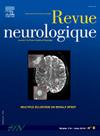Quality of life in patients with spontaneous intracranial hypotension: A systematic review and meta-analysis
IF 2.3
4区 医学
Q2 CLINICAL NEUROLOGY
引用次数: 0
Abstract
Background
Not only are diagnosis and management of spontaneous intracranial hypotension (SIH) challenging due to heterogeneous symptoms and limited treatment effectiveness, but SIH's impact on health-related quality of life (HRQoL) is under-documented.
Objectives
In this systematic review, we aim to evaluate the assessment of QoL in SIH patients, identify impacted QoL domains, and explore treatment-related changes in QoL with a meta-analysis.
Methods
Following PRISMA recommendations, we conducted a systematic literature search using a comprehensive set of keywords related to QoL and SIH. Databases were searched from the inception to July 2025. Studies were included if they provided reports on the quality of life for SIH patients. A meta-analysis using mean difference (MD) of baseline and after-treatment QoL scores was conducted. The risk of bias was assessed using the Newcastle-Ottawa scale.
Results
Of 1435 initial publications, 20 studies met the inclusion criteria, representing a total of 1106 patients with SIH. EQ-5D-5L and HIT-6 were the most frequently used tools, with pooled results showing significant improvement post-treatment in perceived health (Visual analog scale score improved from 38.9 to 72.2; MD of 42.4 [95% CI 26.2–58.7]) and headache impact (HIT-6 scores improved from 66.1 to 49.3; MD of 20.1 [95% CI: 14.7–25.6]). Despite treatment, studies reported moderate to severe physical, mental, and social limitations.
Discussion
The reporting of QoL is inconsistent and the tools used to assess QoL in SIH patients are heterogenous. While treatment provides help, some symptoms persist and highlight the need for specific QoL assessment, with tools tailored to SIH.
自发性颅内低血压患者的生活质量:一项系统回顾和荟萃分析。
背景:自发性颅内低血压(SIH)的诊断和治疗不仅由于症状异质性和治疗效果有限而具有挑战性,而且SIH对健康相关生活质量(HRQoL)的影响文献不足。目的:在本系统综述中,我们旨在通过荟萃分析评估SIH患者生活质量的评估,确定影响生活质量的域,并探讨治疗相关的生活质量变化。方法:根据PRISMA的建议,我们使用与QoL和SIH相关的综合关键词进行了系统的文献检索。数据库从开始到2025年7月进行了检索。提供SIH患者生活质量报告的研究被纳入。采用基线和治疗后生活质量评分的平均差异(MD)进行meta分析。偏倚风险采用纽卡斯尔-渥太华量表进行评估。结果:在1435篇首次发表的文献中,有20篇研究符合纳入标准,共纳入1106例SIH患者。EQ-5D-5L和HIT-6是最常用的工具,综合结果显示治疗后感知健康状况有显著改善(视觉模拟量表得分从38.9提高到72.2;MD为42.4 [95% CI 26.2-58.7])和头痛影响(HIT-6评分从66.1提高到49.3;MD为20.1 [95% CI: 14.7-25.6])。尽管接受了治疗,研究仍报告了中度至重度的身体、精神和社会限制。讨论:生活质量的报告不一致,用于评估SIH患者生活质量的工具也各不相同。虽然治疗提供了帮助,但一些症状仍然存在,因此需要使用针对SIH的工具进行具体的生活质量评估。
本文章由计算机程序翻译,如有差异,请以英文原文为准。
求助全文
约1分钟内获得全文
求助全文
来源期刊

Revue neurologique
医学-临床神经学
CiteScore
4.80
自引率
0.00%
发文量
598
审稿时长
55 days
期刊介绍:
The first issue of the Revue Neurologique, featuring an original article by Jean-Martin Charcot, was published on February 28th, 1893. Six years later, the French Society of Neurology (SFN) adopted this journal as its official publication in the year of its foundation, 1899.
The Revue Neurologique was published throughout the 20th century without interruption and is indexed in all international databases (including Current Contents, Pubmed, Scopus). Ten annual issues provide original peer-reviewed clinical and research articles, and review articles giving up-to-date insights in all areas of neurology. The Revue Neurologique also publishes guidelines and recommendations.
The Revue Neurologique publishes original articles, brief reports, general reviews, editorials, and letters to the editor as well as correspondence concerning articles previously published in the journal in the correspondence column.
 求助内容:
求助内容: 应助结果提醒方式:
应助结果提醒方式:


